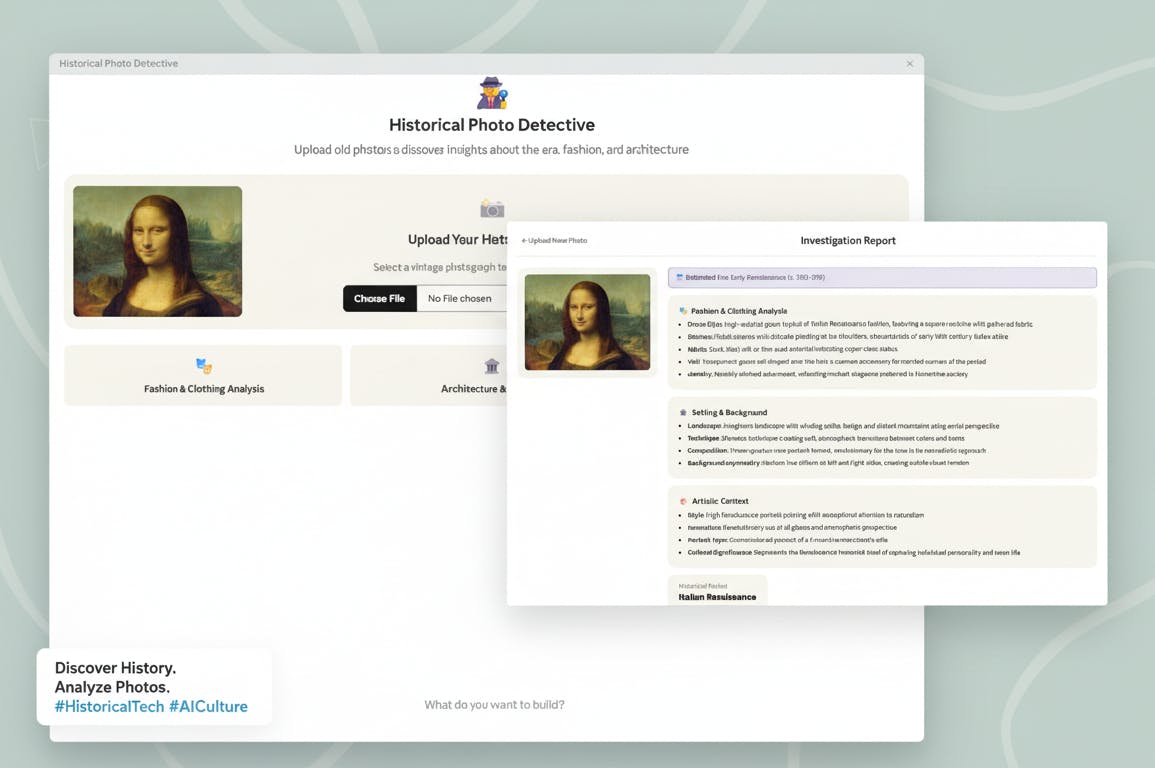And I’m still processing what it means for software development
Here’s my journey in three acts:
Act 1: Traditional coding took me 3-4 months for a simple functional app.
Act 2: AI coding tools? Same app in under 4 weeks. Game-changer.
Act 3: Imagine with Claude? Minutes. And the app built itself as I used it.
Let me explain what just happened.
The Moment It Clicked
I wanted to build a Historical Photo Detective upload old photos, get instant analysis of the era, fashion, architecture, cultural context. Standard prototype stuff.
My exact prompt was:
“Build a Historical Photo Detective – Upload old photos and get context about the era, fashion, architecture visible”
That’s it. One sentence.
Then something unexpected happened:
My initial prompt created a landing page with an upload button. When I clicked it, Claude wrote the upload code right then and showed me a file picker. After I uploaded a photo, the system figured out the next step processing and implemented it on the fly.
Here’s the key insight: The app didn’t exist when I started. It materialized through my interactions.
Each action I took triggered specific code generation. No follow-up prompts. No hand-holding. Just natural usage.
Testing with the Mona Lisa
I downloaded a picture of the Mona Lisa to test the system.
Uploaded it. The application immediately recognized it and gave me:
- What it was (the Mona Lisa)
- Who painted it (Leonardo da Vinci)
- Historical period (Renaissance)
- Artistic techniques used
- Cultural significance
I didn’t program any recognition system. I didn’t train a model. I didn’t build lookup databases.
I just described what I wanted, used the app naturally, and it worked.
This is an alpha release from Anthropic for select Max subscribers. And it’s showing us something fundamentally new
I’m Calling It: Just-In-Time App Generation
Traditional development works like this:
Requirements → Design → Code → Test → Deploy → Use
AI-assisted development shortened it to:
Describe → Generate Code → Use
But JIT Generation flips the entire model:
Use → Code Generates → Use More → More Code Generates
The application writes itself incrementally, action by action, based on what you actually do not what you predicted you’d need.
What Makes This Different from Everything Else
I’ve used Claude Code, Cursor, Replit, Windsurf. They’re all excellent AI coding tools. But this is fundamentally different.
Traditional AI Coding Tools:
- You write prompts constantly
- You guide: “add this feature,” “fix that bug,” “create this component”
- You hand-hold the entire process
- Front-end knowledge is essential
- It’s prompt engineering from start to finish
Imagine with Claude:
- You describe the app once
- You just use it naturally
- It builds itself based on your navigation
- Minimal technical knowledge needed
- No prompting after the initial description
The difference? Prompt-driven versus navigation-driven development.
With traditional tools, you’re still a developer giving instructions. With JIT Generation, you’re a user, and the system infers what code it needs from how you interact.
The Technical Reality
Current limitation: 100,000 token context window
For an alpha release, that’s reasonable. It handles:
- Focused prototypes
- Single-feature demos
- MVP validation
- Smaller applications
Not enough for enterprise-scale apps with dozens of features. But that’s not the point right now.
Who Should Care About This
Product Managers
You can finally visualize how the app works without waiting for design or dev cycles. Describe the concept, get a working prototype, show stakeholders, gather feedback on real interactions all in the same meeting.
Timeline shift: Idea to functional demo in minutes instead of weeks.
UX/UI Designers
Skip the entire handoff process. Design in your head, describe it, use the working prototype, see what feels wrong, adjust immediately.
No more “move that button 2px left” tickets. Just real-time iteration.
Founders Without Technical Co-founders
The validation barrier just disappeared. Describe your idea, test it, share it, gather feedback all before end of day.
You don’t need to hire a developer to validate your concept anymore.
Current Limitations (Being Realistic)
Restricted Alpha Access
Only available to select Max subscribers. Not widely accessible yet.
No Persistence
Refresh your browser? Everything’s gone. Great for ideation sessions, not for ongoing development.
Prototyping Focus
Imagine with Claude creates interactive prototypes with UI interfaces, frontend logic, and can even access hardware features like device cameras for mobile simulations.
But it’s NOT designed for production apps requiring:
- Backend infrastructure
- Database integration
- API architectures
- Enterprise scalability
- Multi-service coordination
This is a prototyping engine, not a full-stack replacement.
Context Limits
100K tokens works for prototypes, not complex applications. Production versions will likely expand this significantly.
Why This Matters
When prototyping becomes this effortless:
- Validation cycles collapse from weeks to hours
- Product managers become builders, not just documenters
- Experimentation cost approaches zero
- The gap between imagination and reality disappears
We’re witnessing a shift from “describe what you want the code to do” to “use the app and it figures out what code it needs.”
That’s profound.
What Happens When JIT Becomes Production-Ready?
Right now, this is alpha. Experimental. Prototype-focused.
But when JIT Generation reaches production maturity with full-stack capabilities:
- Apps get built without traditional coding workflows
- Complete applications generate (frontend, backend, databases, APIs)
- The developer role transforms fundamentally
- Other companies will adopt similar approaches (competition accelerates innovation)
I’m particularly interested in seeing full-stack applications built this way systems that generate entire architectures: backend services, database schemas, API endpoints, authentication systems, the works.
That’s when the real revolution begins.
Try It Yourself
If you have alpha access:
- Go to claude.ai/imagine
- Think of a simple tool (respect the 100K token limit)
- Describe it once, then just use it stop prompting
- Let your navigation drive the development
- Test with real data (try the Mona Lisa!)
- Share with someone for immediate feedback
Even though it’s temporary and imperfect, you’ll understand the shift happening here.
The Bottom Line
I’ve gone from months to weeks to minutes.
But this isn’t about speed. It’s about a fundamental shift in how software gets created.
Apps aren’t something you build anymore. They’re something you discover through use.
Imagine with Claude is alpha release with real constraints restricted access, no persistence, token limits, prototype-only focus. But it’s showing us a future where:
- Building and using are the same activity
- Prompting gets replaced by navigation
- Technical barriers lower significantly
- Ideation happens at the speed of thought
This is Just-In-Time App Generation.
I’m still processing what it means. And I’m eagerly waiting to see full-stack versions of this concept. That’s when things get really interesting.
Have you tried Imagine with Claude? What did you build? How does navigation-driven development feel compared to traditional prompting?
Share your experiences in the comments I want to hear what others are discovering. n











